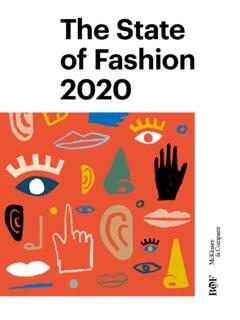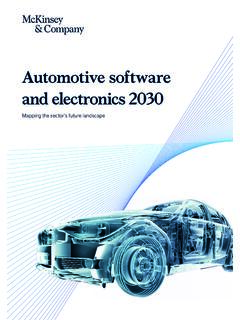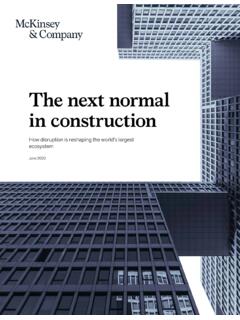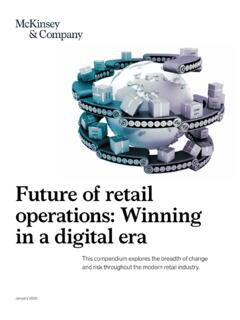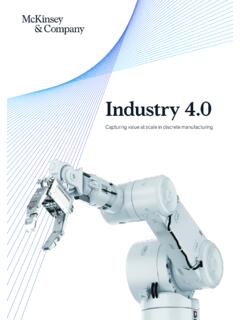Transcription of Climate risk and response - McKinsey & Company
1 Climate risk and response : Physical hazards and socioeconomic impactsJanuary 2020 Climate risk and responsePhysical hazards and socioeconomic impactsMcKinsey Global InstituteSince its founding in 1990, the McKinsey Global Institute (MGI) has sought to develop a deeper understanding of the evolving global economy. As the business and economics research arm of McKinsey & Company , MGI aims to provide leaders in the commercial, public, and social sectors with the facts and insights on which to base management and policy decisions. MGI research combines the disciplines of economics and management, employing the analytical tools of economics with the insights of business leaders. Our micro-to-macro methodology examines microeconomic industry trends to better understand the broad macroeconomic forces affecting business strategy and public policy.
2 MGI s in-depth reports have covered more than 20 countries and 30 industries. Current research focuses on six themes: productivity and growth, natural resources, labor markets, the evolution of global financial markets, the economic impact of technology and innovation, and urbanization. Recent reports have assessed the digital economy, the impact of AI and automation on employment, income inequality, the productivity puzzle, the economic benefits of tackling gender inequality, a new era of global competition, Chinese innovation, and digital and financial globalization. MGI is led by three McKinsey & Company senior partners: James Manyika, Sven Smit, and Jonathan Woetzel. James and Sven also serve as co-chairs of MGI. Michael Chui, Susan Lund, Anu Madgavkar, Jan Mischke, Sree Ramaswamy, Jaana Remes, Jeongmin Seong, and Tilman Tacke are MGI partners, and Mekala Krishnan is an MGI senior teams are led by the MGI partners and a group of senior fellows and include consultants from McKinsey offices around the world.
3 These teams draw on McKinsey s global network of partners and industry and management experts. The MGI Council is made up of leaders from McKinsey offices around the world and the firm s sector practices and includes Michael Birshan, Andr s Cadena, Sandrine Devillard, Andr Dua, Kweilin Ellingrud, Tarek Elmasry, Katy George, Rajat Gupta, Eric Hazan, Acha Leke, Gary Pinkus, Oliver Tonby, and Eckart Windhagen. The Council members help shape the research agenda, lead high-impact research and share the findings with decision makers around the world. In addition, leading economists, including Nobel laureates, advise MGI partners of McKinsey fund MGI s research; it is not commissioned by any business, government, or other institution. For further information about MGI and to download reports for free, please visit collaboration with McKinsey & Company 's Sustainability and Global Risk practiciesMcKinsey & Company s Sustainability Practice helps businesses and governments reduce risk, manage disruption, and capture opportunities in the transition to a low-carbon, sustainable-growth economy.
4 Clients benefit from our integrated, system-level perspective across industries from energy and transport to agriculture and consumer goods and across business functions from strategy and risk to operations and digital technology. Our proprietary research and tech-enabled tools provide the rigorous fact base that business leaders and government policy makers need to act boldly with confidence. The result: cutting-edge solutions that drive business-model advances and enable lasting performance improvements for new players and incumbents alike. & Company s Global Risk Practice partners with clients to go beyond managing risk to enhancing resilience and creating value. Organizations today face unprecedented levels and types of risk produced by a diversity of new sources. These include technological advances bringing cybersecurity threats and rapidly evolving model and data risk; external shifts such as unpredictable geopolitical environments and Climate change; and an evolving reputational risk landscape accelerated and amplified by social media.
5 We apply deep technical expertise, extensive industry insights, and innovative analytical approaches to help organizations build risk capabilities and assets across a full range of risk areas. These include financial risk, capital and balance sheet related risk, nonfinancial risks (including cyber, data privacy, conduct risk, and financial crime), compliance and controls, enterprise risk management and risk culture, model risk management, and crisis response and resiliency with a center of excellence for transforming risk management through the use of advanced analytics. business-functions/riskAuthorsJonathan Woetzel, ShanghaiDickon Pinner, San FranciscoHamid Samandari, New YorkHauke Engel, FrankfurtMekala Krishnan, BostonBrodie Boland, Washington, DCCarter Powis, TorontoPhysical hazards and socioeconomic impactsClimate risk and responseJanuary 2020 PrefaceMcKinsey has long focused on issues of environmental sustainability, dating to client studies in the early 1970s.
6 We developed our global greenhouse gas abatement cost curve in 2007, updated it in 2009, and have since conducted national abatement studies in countries including Brazil, China, Germany, India, Russia, Sweden, the United Kingdom, and the United States. Recent publications include Shaping Climate -resilient development: A framework for decision-making (jointly released with the Economics of Climate Adaptation Working Group in 2009), Towards the Circular Economy (joint publication with Ellen MacArthur Foundation in 2013), An integrated perspective on the future of mobility (2016), and Decarbonization of industrial sectors: The next frontier (2018). The McKinsey Global Institute has likewise published reports on sustainability topics including Resource revolution: Meeting the world s energy, materials, food, and water needs (2011) and Beyond the supercycle: How technology is reshaping resources (2017).
7 In this report, we look at the physical effects of our changing Climate . We explore risks today and over the next three decades and examine cases to understand the mechanisms through which physical Climate change leads to increased socioeconomic risk. We also estimate the probabilities and magnitude of potential impacts. Our aim is to help inform decision makers around the world so that they can better assess, adapt to, and mitigate the physical risks of Climate change. This report is the product of a yearlong, cross-disciplinary research effort at McKinsey & Company , led by MGI together with McKinsey s Sustainability Practice and McKinsey s Risk Practice. The research was led by Jonathan Woetzel, an MGI director based in Shanghai, and Mekala Krishnan, an MGI senior fellow in Boston, together with McKinsey senior partners Dickon Pinner in San Francisco and Hamid Samandari in New York, partner Hauke Engel in Frankfurt, and associate partner Brodie Boland in Washington, DC.
8 The project team was led by Tilman Melzer, Andrey Mironenko, and Claudia Kampel and consisted of Vassily Carantino, Peter Cooper, Peter De Ford, Jessica Dharmasiri, Jakob Graabak, Ulrike Grassinger, Zealan Hoover, Sebastian Kahlert, Dhiraj Kumar, Hannah Murdoch, Karin stgren, Jemima Peppel, Pauline Pfuderer, Carter Powis, Byron Ruby, Sarah Sargent, Erik Schilling, Anna stanley , Marlies Vasmel, and Johanna von der Leyen. Brian Cooperman, Eduardo Doryan, Jose Maria Quiros, Vivien Singer, and Sulay Solis provided modeling, analytics, and data support. Michael Birshan, David Fine, Lutz Goedde, Cindy Levy, James Manyika, Scott Nyquist, Vivek Pandit, Daniel Pacthod, Matt Rogers, Sven Smit, and Thomas Vahlenkamp provided critical input and considerable McKinsey employs many scientists, including Climate scientists, we are not a Climate research institution.
9 Woods Hole Research Center (WHRC) produced the scientific analyses of physical Climate hazards in this report. WHRC has been focused on Climate science research since 1985; its scientists are widely published in major scientific journals, testify to lawmakers around the world, and are regularly sourced in major media outlets. Methodological design and results were independently reviewed by senior scientists at the University of Oxford s Environmental Change Institute to ensure impartiality and test the scientific foundation for the new analyses in this report. Final design choices and interpretation of Climate hazard results were made by WHRC. In addition, WHRC scientists produced maps and data visualization for the would like to thank our academic advisers, who challenged our thinking and added new insights: Dr.
10 Richard N. Cooper, Maurits C. Boas Professor of International Economics at Harvard University; Dr. Cameron Hepburn, director of the Economics of Sustainability iiMcKinsey Global Institute Programme and professor of environmental economics at the Smith School of Enterprise and the Environment at Oxford University; and Hans-Helmut Kotz, Program Director, SAFE Policy Center, Goethe University Frankfurt, and Resident Fellow, Center for European Studies at Harvard would like to thank our advisory council for sharing their profound knowledge and helping to shape this report: Fu Chengyu, former chairman of Sinopec; John Haley, CEO of Willis Towers Watson; Xue Lan, former dean of the School of Public Policy at Tsinghua University; Xu Lin, US China Green Energy Fund; and Tracy Wolstencroft, president and chief executive officer of the National Geographic Society.


